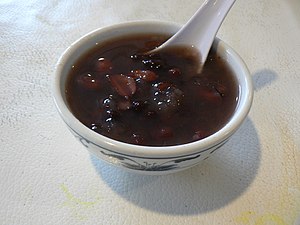
China
In
China, red bean soup (紅豆汤, pinyin: hóng dòu tāng) is a popular dish. The soup is commonly thinner than the Japanese oshiruko version. It is categorized as a
tang shui糖水, (pinyin: táng shǔi) (literally translated as sugar water), or sweet soup. It is often served cold during the summer, and hot in the winter. Leftover red bean soup can also be frozen to make
ice pops and is a popular dessert.
In
Cantonese cuisine, a red bean soup made from rock sugar,
sun-dried tangerine peels, and
lotus seeds is commonly served as a dessert at the end of a restaurant or banquet meal. Common variations include the addition of ingredients such as
sago (西米, pinyin: xī mi), tapioca, coconut milk, ice cream,
glutinous rice balls, or
purple rice. The two types of sugar used interchangeably are
rock sugar and sliced sugar (片糖).
[1]
Japan
Shiruko (汁粉?), or oshiruko (お汁粉?) with the honorific "o" (お), is a traditional Japanese dessert.[2] It is a sweet porridge of azuki beans boiled and crushed, served in a bowl with mochi.[2][3] There are different styles of shiruko, such as shiruko with chestnuts, or with glutinous rice flour dumplings instead of mochi.
There are two types of shiruko based on different methods of cooking azuki beans. Azuki beans may be turned into paste, crushed without keeping their original shape, or a mix of paste and roughly crushed beans.[3] There is a similar dish, zenzai (善哉、ぜんざい?), which is made from condensed paste with heat and is less watery than shiruko, like making jam or marmalade. In Western Japan, Zenzai refers to a type of shiruko made from a mixture of paste and crushed beans.[3] In Okinawa Prefecture, the term "zenzai" commonly refers to this bean soup served over shaved ice with "mochi". Other toppings, such as sweetened condensed milk, are occasionally added for flavor.
It is loved by many Japanese, especially during the winter.[3] The half-melted sticky mochi and the sweet, warm azuki bean porridge is thought by many to be an absolute delight. Shiruko is frequently served with a side dish of something sour or salty, such as umeboshi or shiokombu to refresh the palate as shiruko is so sweet that the taste may cloy after a while.

No comments:
Post a Comment